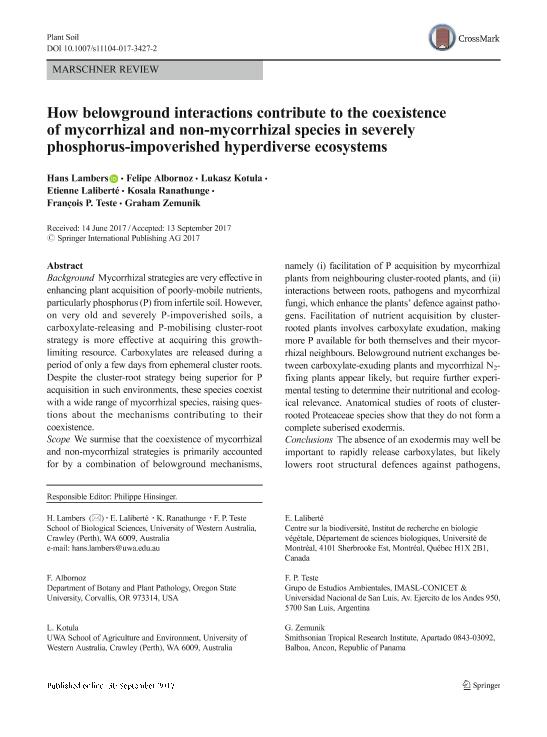Artículo
How belowground interactions contribute to the coexistence of mycorrhizal and non-mycorrhizal species in severely phosphorus-impoverished hyperdiverse ecosystems
Lambers, Hans; Albornoz, Felipe; Kotula, Lukasz; Léveillé Bourret, Étienne; Ranathunge, Kosala; Teste, Francois ; Zemunik, Graham
; Zemunik, Graham
 ; Zemunik, Graham
; Zemunik, Graham
Fecha de publicación:
03/2018
Editorial:
Springer
Revista:
Plant and Soil
ISSN:
0032-079X
e-ISSN:
1573-5036
Idioma:
Inglés
Tipo de recurso:
Artículo publicado
Clasificación temática:
Resumen
Background: Mycorrhizal strategies are very effective in enhancing plant acquisition of poorly-mobile nutrients, particularly phosphorus (P) from infertile soil. However, on very old and severely P-impoverished soils, a carboxylate-releasing and P-mobilising cluster-root strategy is more effective at acquiring this growth-limiting resource. Carboxylates are released during a period of only a few days from ephemeral cluster roots. Despite the cluster-root strategy being superior for P acquisition in such environments, these species coexist with a wide range of mycorrhizal species, raising questions about the mechanisms contributing to their coexistence. Scope: We surmise that the coexistence of mycorrhizal and non-mycorrhizal strategies is primarily accounted for by a combination of belowground mechanisms, namely (i) facilitation of P acquisition by mycorrhizal plants from neighbouring cluster-rooted plants, and (ii) interactions between roots, pathogens and mycorrhizal fungi, which enhance the plants’ defence against pathogens. Facilitation of nutrient acquisition by cluster-rooted plants involves carboxylate exudation, making more P available for both themselves and their mycorrhizal neighbours. Belowground nutrient exchanges between carboxylate-exuding plants and mycorrhizal N2-fixing plants appear likely, but require further experimental testing to determine their nutritional and ecological relevance. Anatomical studies of roots of cluster-rooted Proteaceae species show that they do not form a complete suberised exodermis. Conclusions: The absence of an exodermis may well be important to rapidly release carboxylates, but likely lowers root structural defences against pathogens, particularly oomycetes. Conversely, roots of mycorrhizal plants may not be as effective at acquiring P when P availability is very low, but they are better defended against pathogens, and this superior defence likely involves mycorrhizal fungi. Taken together, we are beginning to understand how an exceptionally large number of plant species and P-acquisition strategies coexist on the most severely P-impoverished soils.
Archivos asociados
Licencia
Identificadores
Colecciones
Articulos(IMASL)
Articulos de INST. DE MATEMATICA APLICADA DE SAN LUIS
Articulos de INST. DE MATEMATICA APLICADA DE SAN LUIS
Citación
Lambers, Hans; Albornoz, Felipe; Kotula, Lukasz; Léveillé Bourret, Étienne; Ranathunge, Kosala; et al.; How belowground interactions contribute to the coexistence of mycorrhizal and non-mycorrhizal species in severely phosphorus-impoverished hyperdiverse ecosystems; Springer; Plant and Soil; 424; 1-2; 3-2018; 11-33
Compartir
Altmétricas



